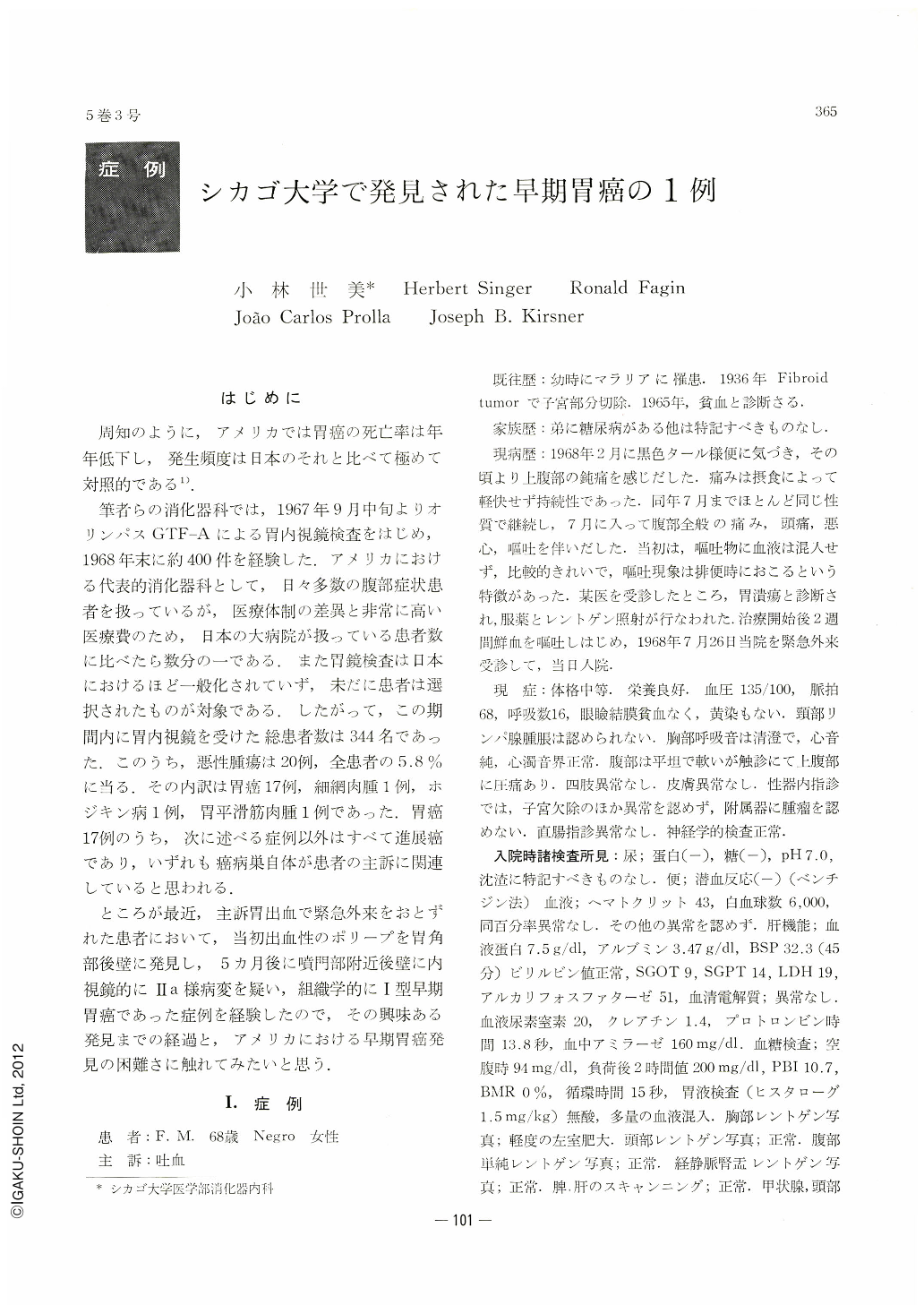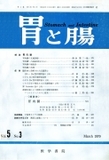Japanese
English
- 有料閲覧
- Abstract 文献概要
- 1ページ目 Look Inside
はじめに
周知のように,アメリカでは胃癌の死亡率は年年低下し,発生頻度は日本のそれと比べて極めて対照的である1).
筆者らの消化器科では,1967年9月中旬よリオリンパスGTF-Aによる胃内視鏡検査をはじめ,1968年末に約400件を経験した,アメリカにおける代表的消化器科として,日々多数の腹部症状患者を扱っているが,医療体制の差異と非常に高い医療費のため,日本の大病院が扱っている患者数に比べたら数分の一である.また胃鏡検査は日本におけるほど一般化されていず,未だに患者は選択されたものが対象である.したがって,この期間内に胃内視鏡を受けた総患者数は344名であった.このうち,悪性腫瘍は20例,全患者の5.8%に当る.その内訳は胃癌17例,細網肉腫1例,ポジキン病1例,胃平滑筋肉腫1例であった.胃癌17例のうち,次に述べる症例以外はすべて進展癌であり,いずれも癌病巣自体が患者の主訴に関連していると思われる.
ところが最近,主訴胃出血で緊急外来をおとずれた患者において,当初出血性のポリープを胃角部後壁に発見し,5カ月後に噴門部附近後壁に内視鏡的にⅡa様病変を疑い,組織学的に1型早期胃癌であった症例を経験したので,その興味ある発見までの経過と,アメリカにおける早期胃癌発見の困難さに触れてみたいと思う.
Introduction: The incidence of gastric carcinoma has been decreasing in the United States and is quite contrary to that in Japan. However, most cases detected here are already advanced carcinoma which has invaded the muscularis propria or serosa, most frequently with further metastasis. Recently, we have observed a case of superficial carcinoma limited to the mucosa, in which a correct diagnosis was made by all endoscopical procedures including direct vision cytology and biopsy. This experience is reported to emphasize the occurrence of this type of gastric lesion which probably is more common in the United States than may have been appreciated.
Case: A 68-year old Negro female was admitted to the University of Chicago Hospitals in July, 1968, with a 4-months history of tarry stools and epigastric pain. Gastroscopy performed on the day of admission revealed a peclunculated polypoid mass on the posterior aspect of the proximal antrum. Because of the active bleeding, gastric lavage was performed prior to endoscopy with the installation and aspiration of ice-water through a large bore Ewald tube. The gastric contents aspirated through the Ewald tube at this time included several blood clots and a specimen of friable, necrotic tissue 2 cm in diameter. Cytological and histopathological examinations of the tissue were positive for malignant cells and adenocarcinoma, respectively. An exploratory laparotomy was performed on the same day and a polypoid lesion, histologically benign on frozen section, was removed from the posterior wall of the proximal antrum. Examination of the remaining gastric mucosa revealed no evidence of an additional lesion. Permanent sections of the surgically removed gastric lesion confirmed the frozen tissue diagnosis of a benign adenomatous polyp. As the source of the adenocarcinoma was unknown, the patient was reevaluated 10 days postoperatively with an upper gastrointestinal series, gastric washing cytologies, and repeat gastroscopy; all of these studies were negative for malignancy and the patient was discharged, to be followed in the outpatient clinic.
Although the patient remained asymptomatic, she was again admitted to the hospital in December, 1968, for further evaluation. A second upper gastrointestinal examination on December 9 th showed a normal esophagus, stomach and duodenum. The third gastroscopy performed on December 11 th did not demonstrate any particular lesion except scar tissue from the previous gastric surgery; esophagoscopy on the same day was normal. The fourth cytological examination was performed on December 17 th and was negative for malignant cells. The fourth gastroscopy was performed on December 20th and showed a 1.5×1.5 cm sessile polyp with a nodular surface located approximately 3cm. from the gastroesophageal junction on the posterior aspect of the fundus. This lesion was considered to be a Ⅱa type of early gastric carcinoma as defined by the Japanese Gastroenterological Endoscopy Society. Gastric brushings for cytology and biopsies were obtained from this lesion simultaneously under direct vision using the GFB fibergastroscope. The cytological material was positive for malignant cells and histological sections of the biopsy material showed papillary adenocarcinoma with signet ring cells.
On January 2nd, the patient was taken to the operating room and the proximal two-thirds of her stomach was removed. The patient's recovery from surgery was uneventful and she was discharged 10 days after the operation in good condition. Serial sections of the tumor revealed a well differentiated adenocarcinoma which exhibited moderate cellular and nuclear atypia. The cancer was limited to the lamina propria. Several lymph nodes were examined and showed no evidence of metastasis.
Discussion: In retrospect, several aspects of this case merit reconsideration. The initial gastroscopy demonstrated a bleeding polypoid lesion which was the obvious cause of the patient's immediate problem. As the patient's clinical condition was somewhat tenuous in the face of active bleeding, this initial gastroscopy was terminated without a complete examination of the stomach having been performed; because there was no reason to suspect more than a single lesion.
At the time of the initial operation, the surgeon was aware of a positive cytological report; however, he failed to identify the second gastric lesion in the fundus. The failure to detect the funclal lesion in this instance may be attributed to the following two factors: (1) the incision for polypectomy did not extend for a sufficient distance to permit localization of a high fundal lesion and (2) the detection of small gastric lesions by palpation at the time of surgery is difficult, especially in the case of a superficial carcinoma. Inspection of the stomach through a gastro-viewer at the time of surgery is a very helpful procedure and may have prevented the initial failure to detect the fundal lesion.
Past experience has shown that gastric washing is the most effective cytological method for detecting malignant disease in the funclus and upper body of the stomach. However, routine cytologic washings performed three times during this patient's follow-up period were negative for malignant cells. A gastric brushing of this lesion was readily successful in demonstrating its malignant nature. Diagnostic accuracy in the detection of adenocarcinoma in our cytology laboratory on washing specimens is 91%. Therefore, we were surprised that the location of the lesion, the high percentage of accurate examinations in our laboratory, and the numerous procedures performed on this patient did not provide us with a positive result from the routine cytologic washings. It may well be that the brushing method is a worthwhile complementary technique for demonstrating superficial types of carcinoma, especially if the lesion is a protruding one like type Ⅰ or Ⅱa.
Direct vision biopsy using the fibergastroscope also was successful in confirming the diagnosis of adenocarcinoma prior to surgery. Although it has been generally believed that biopsy of lesions near the gastroesophageal Junction is technically difficult, we experienced no trouble in obtaining the appropriate tissue in this case.
In view of our experience, we believe the fibergastroscope should be utilized more often for obtaining cytological and biopsy material under direct vision. Supplementing routine x-ray and gastroscopic examinations with such cytological and biopsy material would decrease the likelihood of missing a malignant gastric lesion and improve the opportunity of detecting such a malignancy at an ear-lier stage, when it is most ammenable to treatment.
We aknowledge hith pleasure the contribution of Dr. Tatsuzo Kasugai at Aichi Cancer Center Hospital to this report and of Mr. Leroy Cockerham, our Chief Gartroenterology Cytotechnician, in preparing the photographs of this report.

Copyright © 1970, Igaku-Shoin Ltd. All rights reserved.


